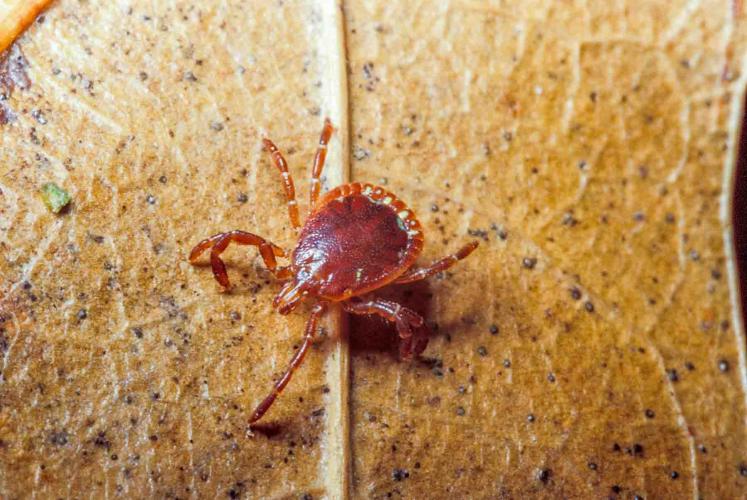
A four-day Fourth of July weekend spent at a friend’s property in 2005 launched a 17-year journey that David Seyer never anticipated.
That weekend, Seyer, of St. Clair, helped build a hunting cabin on a friend’s land in Putnam County, near Mineral Hills Conservation Area. A few days later, Seyer found two ticks embedded on his body. He pulled them off and didn’t give it another thought.
Two to three months later, he began having unusual symptoms that worsened over time — chronic neck pain and swelling, testicular pain, difficulty walking, irregular heartbeat, bell’s palsy, and stomach issues, which lead to an intolerance for meat.
After several trips to a variety of doctors, and a host of misdiagnoses, including being told it’s all in his head, Seyer was finally told in 2008 that he has Borrelia burgdorferi, the bacteria that causes Lyme disease.
“I was relieved,” Seyer said. “I thought, finally a diagnosis. Now, I can start the process of getting well.”
Little did he know, the path to wellness was not going to be smooth.
Traditional antibiotics were not working, so he stopped those. He continues to receive massage therapy to keep his lymphatic system moving. He has tried a multitude of experimental treatments, though none of them are covered by insurance. He estimates he and his wife, Wanda, have spent upwards of $100,000 in search of relief, and he’s still in pain.
“Many doctors are just uneducated,” Seyer said. “They just don’t know. I don’t want to see anyone else go through what I am going through.”
Though Lyme disease is not common in Missouri, Ehrlichia and Rickettsia diseases are. MDC hopes a recently completed two-year tick study will better inform the public — and the medical community — about ticks and tick-borne illness so stories like Seyer’s may be prevented.
Tick Study
To determine the presence of tick species, and the pathogens they may harbor, MDC, in partnership with A.T. Still University (ATSU), Kirksville, launched a two-year research study in April 2021.
“We knew it would be impossible to hire a crew big enough to collect ticks statewide, so we turned to citizen science,” said Matt Combes, MDC Ecological Health Unit science supervisor. “Citizen science has proven effective for Stream Teams and other projects for years. It allows us to accomplish data collection and disease ecology surveillance at a scale unattainable by scientists alone.”
During those two years, citizens were asked to place live ticks in plastic, zip-top bags with a piece of damp paper towel or moist cotton ball, with a completed sample submission form, found on ATSU’s website. The ticks were then mailed to ATSU where the ticks were identified to species and a subset of those ticks were tested for four genera of bacteria that cause human disease.
In the Lab
Deb Hudman, senior research associate at ATSU’s Microbiology and Immunology Department, received the ticks by mail from counties across the state. Once received, each tick was identified, given a number, and placed in ethanol. Up to 10 individual ticks of four human biting species from each county were tested for bacterial pathogens that infect humans.
Maps were created and updated weekly on the ATSU website so citizens could see in real time where ticks were coming from and their pathogens.
“We were creating a baseline data set,” Hudman said. “Missouri has a diverse and abundant tick population that is poorly understood due to lack of tick surveillance and information sharing. There are many tick-borne human pathogens in the state, but there is no comprehensive map of where tick species occur, or of the human pathogens those ticks are carrying.”
The maps born from this study — a first for the state — will be shared with the Centers for Disease Control and Prevention and the Missouri Department of Health and Senior Services, who will in turn share them with county health departments. This information will help educate local physicians about the ticks found in their area and the disease-causing pathogens present.
“There is a pressing need to increase tick surveillance in Missouri, develop statewide distribution maps of tick species and tick-borne pathogens, and educate the public on reducing their risk of contracting a tick-borne disease based on that data,” Combes said.
Findings
By the end of the survey period, 17,466 ticks were submitted by citizen scientists. Of those, 71 percent were lone star ticks, 26 percent were American dog ticks, 2 percent were blacklegged ticks, and the remaining 1 percent consisted of five different tick species.
Rickettsia parkeri was detected in 8 percent of the Gulf Coast ticks, anaplasmosis and Lyme disease in combination was found in 3 percent of the blacklegged ticks, ehrlichiosis and tularemia in combination was found in 5 percent of the lone star ticks, and tularemia and Rickettsia montanensis in combination was found in 6 percent of the American dog ticks.
So far 2,462 individual ticks have been tested with 134 those testing positive for a human pathogen for an overall infection rate of 5 percent.
Medical Care
Ticks do everything they can to go undetected.
“When they bite, they release antihistamines and anticoagulants, and if still undetected they put in a cementing agent to hold themselves in place,” Hudman said.
Ticks ingest blood from a host until they are full. They require three blood meals to complete their life cycle, and with each meal, their chance for acquiring pathogens increases.
If you find a tick attached to you, remove it and stick it on a piece of clear tape. Put it on the calendar on the date you found it. If after 10 days, you feel good, you can throw it away. If you are feeling flu-like symptoms in those 10 days — tired, achy, or see a rash developing — you may have a tick-borne illness. Seek medical advice and take the tick with you.
Prevention is Key
Without a doubt, this study shows ticks are part of Missouri’s landscape. But don’t let ticks prevent you from enjoying the outdoors and your favorite activities. There are things you can do to continue to reap the benefits of nature while avoiding negative interactions with ticks:
Use insect repellant. Spray yourself liberally before heading outside.
Dress appropriately. Light-colored, long-sleeved shirts and long pants are best. For further protection, tuck your pants into your socks. As an added step, look for clothes pre-treated with insecticide.
Stay on walking paths. Don’t venture into heavy vegetation.
Check, check, and then check again. Check yourself outside frequently. Check yourself again as soon as you get home, and then shower. The sooner you remove a tick, the lower your risk of disease.
Manage your habitat. Ticks avoid bare ground and prefer areas with leaf litter. Therefore, keep your land well managed. Look into prescribed burning, mowing, and landscaping.
Treat your pets. Dogs and cats carry ticks and can easily bring them indoors. Prevent this by treating your pets for ticks.
To access the Missouri Tickborne Disease Story Map on the Missouri Health and Senior Services website, visit short.mdc.mo.gov/4f3.












Also In This Issue

Protections, restoration boost bald eagle resurgence

A monthly to-do guide to help you get the most out of Missouri’s hunting seasons
And More...
This Issue's Staff
Editor - Angie Daly Morfeld
Associate Editor - Larry Archer
Photography Editor - Cliff White
Staff Writer - Kristie Hilgedick
Staff Writer - Joe Jerek
Staff Writer – Dianne Van Dien
Designer - Shawn Carey
Designer - Marci Porter
Photographer - Noppadol Paothong
Photographer - David Stonner
Circulation - Laura Scheuler






















